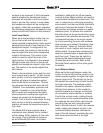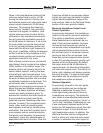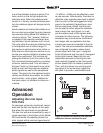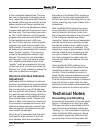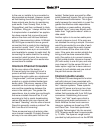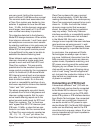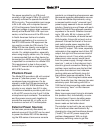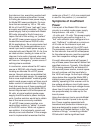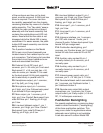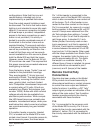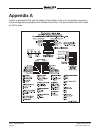
Issue 1, September 2007 Model 233 User Guide
Page 38 Studio Technologies, Inc.
the intercom line, everything worked well.
But a new problem arose when it came
to finding an external linear power supply
for Model 233 users worldwide. For loca-
tions that are served by 100 or 120 volts,
60 Hz a 24 volt DC linear “wall-wart” pow-
er supply was readily available. This is the
power supply that is provided with Model
233 units shipped to North America or
Japan. But as of this writing, no “perfect”
24 volt DC linear power source has been
located that would serve 220/240 volts,
50 Hz applications. So a compromise had
to be made. For these applications a uni-
versal input switch-mode power supply is
included with each Model 233. It’s far from
an ideal solution, leading to noise on the
intercom line’s audio channels when long
cable runs are present. But at least users
will have an “emergency” power source if
nothing else is available.
In conclusion, users where the AC mains
source is 220/240 volts should consider
locating an alternate 24 volt DC power
source. Several options are available that
could make the task simple. It’s expected
that a more sophisticated “medical-grade”
switch-mode power supply will have much
better control of induced noise. It’s highly
likely that using one of these supplies will
provide good results. As the Model 233’s
current requirement is 90 milliamperes at
24 volts, a typical medical-grade power
supply should be able to power multiple
units. Another solution would be to obtain
two of the more commonly available
12 volt DC linear power supplies, con-
necting their outputs in “series” to create
a 24 volt DC source. While not a glamor-
ous solution, it is technically correct and
should prove cost effective. If this arrange-
ment is implemented remember that the
center pin of the 2.1 x 5.5 mm coaxial jack
is used for the positive (+) connection.
Symptoms of Insufficient
Power
A core part of the Model 233’s internal
circuitry is a switch-mode power supply
that produces +48 volts, +12 volts,
+5 volts, and –12 volts. This power supply
circuit works very well as long as it is
“fed” with sufficient input voltage and cur-
rent. “Sufficient” is defined as a minimum
of 24 volts on the intercom input and
20 volts on the external 24 volt DC input.
The necessary current, 125 milliamperes
for the intercom line and 90 milliamperes
for the external source, must be supplied
over their respective voltage ranges.
It’s worth discussing what will happen if
any of these power sources fall below their
specified minimum. Typically, if the Model
233 is being powered by an external 24
volt nominal power source, normal opera-
tion will continue until the input falls to
the 18-20 volt range. As the input voltage
drops below this range the Model 233’s
internal power supply will have reduced
stability, operating in this manner until its
low-voltage shutdown circuit halts opera-
tion. Note that as the input voltage moves
down from 24 volts the input current will
rise proportionately to make up for the
loss of power.
Using the intercom line to provide Model
233 power shouldn’t prove to be a prob-
lem. Power supplies associated with
broadcast and production intercom sys-
tems are designed to support multiple
belt-pack and related devices. In the “big
scheme of things,” connecting a Model
233 shouldn’t add a significant load.




